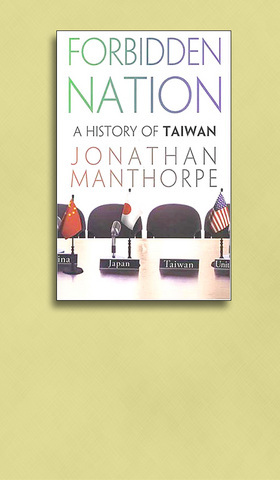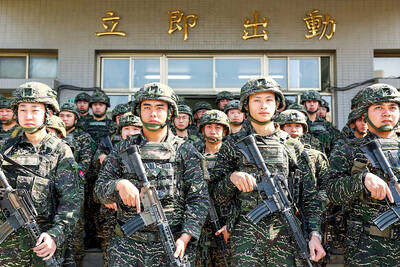A warm welcome is due to a particularly fine book on our island home. It's subtitled A History of Taiwan, and its central chapters do indeed survey the island's paradoxical history in the accustomed manner, though with exceptional clarity. But the greatest strength of Forbidden Nation lies in its treatment of Taiwan's current situation, both internally and as seen from an international perspective.
The book opens with an account of the shooting incident in Tainan on the eve of the 2004 presidential election, and Jonathan Manthorpe's qualities are immediately apparent. He's meticulous but clear-headed, with both the wood and the trees presented in sharp focus. On the one hand Taiwan's media showed itself "scandal and rumor-obsessed," on the other, US forensic expert Henry Lee was "unable to say conclusively that the assassination attempt had not been staged." Few could fault his presentation of the facts, but at the same time he manages to offer a very balanced and fair-minded assessment of this much-analyzed affair.
Then comes the island story, and again the sanity and fairness of the account leaps at you from the page. Everywhere you find the same virtues, displayed in careful yet concise analysis of the pheno-mena, whether it's China's Taiping rebellion or the case of the 18th century impostor George Psalman-azar, who claimed to come from "Formosa."

Most readers of this news-paper will probably be familiar with much of what Manthorpe has to say, with interest inevitably centering on which side he is going to come down on when it comes to the big question of "renegade province" or "de facto independence." Here this author doesn't disappoint. It can be fairly stated that he is a firm opponent of China's claims to hegemony. But nevertheless he is also at pains to point out that Taiwan's very geographical position makes it unavoidably and inextricably vulnerable to the claims of neighboring powers.
A good example of this author's combination of detail and balance comes with the treatment of the life of Chiang Ching-kuo (蔣經國). You know at once that this will be a test case because Manthorpe opens by saying some Taiwanese loathe his name whereas others fete him to the skies. This, you sense, is just the kind of situation the author relishes. So he proceeds with his account, and the result is that you see Chiang as if in a full-length portrait of some Renaissance prince -- opportunistic and Machiavellian on the one hand, but the man who nevertheless shepherded Taiwan into the democratic fold, from whatever personal motives, on the other.
When it comes to the historical basis for China's claim of sovereignty over Taiwan, Manthorpe does not dodge giving his opinion. There's no question that China ever truly ruled the island, he asserts. It's true that prior to the Japanese takeover in 1895 the Qing Dynasty did operate rule of a kind, but this was sporadic, contested, and -- here Manthorpe plays one of his trump cards -- in essence only over the western coastal plain. This is undoubtedly the case. You only have to look at the main map in John Davidson's magisterial tome The Island of Formosa Past and Present, published in 1903, to see that even under Japanese rule the east coast, and the mountains that drop down to it, are labeled "Savage District," in contradis-tinction to the eastern "Territory under actual Japanese adminis-tration." That the situation before the Japanese arrived was little different can't be doubted. And this eastern no-go region on Davidson' s map constitutes some 55 percent to 60 percent of Taiwan's surface area.
The handover of Taiwan to the Chinese Nationalist Party (KMT) by the international community in 1945 was, Manthorpe argues, in essence illegal. This is probably this book's most original point. "China's claim to own Taiwan and its citizens is based on historically frail arguments and outdated legal concepts," he writes. But this is no partisan anti-Beijing, pro-DPP account of Taiwan's history and current situation. Instead, it's a carefully researched and judicious analysis. In rejecting China's histor-ical claims, therefore, the book deserves to be attended to closely. Clarity and justice, not anti-China rhetoric, are Manthorpe's strongest suits.
The same measured approach is found in his treatment of KMT one-party rule. "It must be acknow-ledged ... that the leavening of economic and social development promoted by the [KMT] in the later years of their exclusive rule made the party's style more akin to strict Chinese paternalism than pure totalitarianism," he writes. On the other hand the Chen administration, in promoting Taiwanese consciousness, has acted "not always wisely."
Nonetheless, this book' s funda-mental position is strongly and unambiguously pro-Taiwanese. "The only people who have established sovereignty over Taiwan are the Taiwanese, no one else ... They do not see why they should be expected to give up their current well-established independence, based on democracy and a vibrant market economy, as a pre-condition for talks with a despotic and repressive regime that has little evident political legitimacy beyond the use of force on its own people ... They have only recently extricated themselves from the coils of the corrupt and dictatorial one-party [KMT] state, and see no reason to jump into the arms of another one, the Communist Party of China."
The topics covered by Manthorpe together constitute a minefield, and yet he tip-toes his way through them with great intelligence and discernment. I have by no means read all the recent English-language books analyzing Taiwan's situation. Even so, if asked to recommend a single volume to a student new to Taiwanese affairs, something that would give both a balanced and a comprehensive account of the state of play here both past and present, Forbidden Nation would be the one I would opt for.

That US assistance was a model for Taiwan’s spectacular development success was early recognized by policymakers and analysts. In a report to the US Congress for the fiscal year 1962, former President John F. Kennedy noted Taiwan’s “rapid economic growth,” was “producing a substantial net gain in living.” Kennedy had a stake in Taiwan’s achievements and the US’ official development assistance (ODA) in general: In September 1961, his entreaty to make the 1960s a “decade of development,” and an accompanying proposal for dedicated legislation to this end, had been formalized by congressional passage of the Foreign Assistance Act. Two

Despite the intense sunshine, we were hardly breaking a sweat as we cruised along the flat, dedicated bike lane, well protected from the heat by a canopy of trees. The electric assist on the bikes likely made a difference, too. Far removed from the bustle and noise of the Taichung traffic, we admired the serene rural scenery, making our way over rivers, alongside rice paddies and through pear orchards. Our route for the day covered two bike paths that connect in Fengyuan District (豐原) and are best done together. The Hou-Feng Bike Path (后豐鐵馬道) runs southward from Houli District (后里) while the

President William Lai’s (賴清德) March 13 national security speech marked a turning point. He signaled that the government was finally getting serious about a whole-of-society approach to defending the nation. The presidential office summarized his speech succinctly: “President Lai introduced 17 major strategies to respond to five major national security and united front threats Taiwan now faces: China’s threat to national sovereignty, its threats from infiltration and espionage activities targeting Taiwan’s military, its threats aimed at obscuring the national identity of the people of Taiwan, its threats from united front infiltration into Taiwanese society through cross-strait exchanges, and its threats from

March 31 to April 6 On May 13, 1950, National Taiwan University Hospital otolaryngologist Su You-peng (蘇友鵬) was summoned to the director’s office. He thought someone had complained about him practicing the violin at night, but when he entered the room, he knew something was terribly wrong. He saw several burly men who appeared to be government secret agents, and three other resident doctors: internist Hsu Chiang (許強), dermatologist Hu Pao-chen (胡寶珍) and ophthalmologist Hu Hsin-lin (胡鑫麟). They were handcuffed, herded onto two jeeps and taken to the Secrecy Bureau (保密局) for questioning. Su was still in his doctor’s robes at